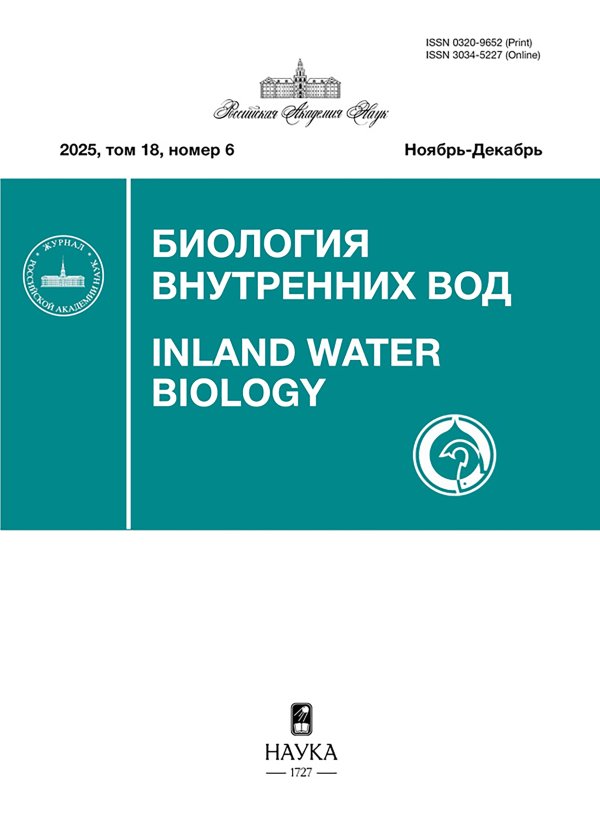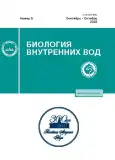Approaches to Determining Reference Values of Physiological Parameters of Freshwater Crayfish (Decapoda, Astacidae)
- Authors: Kuznetsova T.V.1, Ljubimtsev V.A.1, Sladkova S.V.1, Kholodkevich S.V.1
-
Affiliations:
- St. Petersburg Federal Research Center of the Russian Academy of Sciences, Scientific Research Centre for Ecological Safety of the Russian Academy of Sciences
- Issue: No 5 (2023)
- Pages: 699-707
- Section: Articles
- URL: https://journals.rcsi.science/0320-9652/article/view/134926
- DOI: https://doi.org/10.31857/S0320965223050078
- EDN: https://elibrary.ru/RZOFOL
- ID: 134926
Cite item
Full Text
Abstract
Physiological parameters objectively reflect the health state of the organism and can serve as effective auxiliary criteria in determining the quality of the environment. However, significant variability of physiological and biochemical parameters is known in invertebrates, and, in particular, in crustaceans. In order to overcome these limitations and increase certainty in the assessment of the biological effects of toxicants, the authors proposed approaches and methods for the selection of reference groups of crayfish based on monitoring of their heart rate at rest and under the short-term standardized functional tests, allowing to assess the functional state of crayfish and their adaptive capabilities.
About the authors
T. V. Kuznetsova
St. Petersburg Federal Research Center of the Russian Academy of Sciences, Scientific Research Centrefor Ecological Safety of the Russian Academy of Sciences
Author for correspondence.
Email: kuznetsova_tv@bk.ru
Russia, St.-Petersburg
V. A. Ljubimtsev
St. Petersburg Federal Research Center of the Russian Academy of Sciences, Scientific Research Centrefor Ecological Safety of the Russian Academy of Sciences
Email: kuznetsova_tv@bk.ru
Russia, St.-Petersburg
S. V. Sladkova
St. Petersburg Federal Research Center of the Russian Academy of Sciences, Scientific Research Centrefor Ecological Safety of the Russian Academy of Sciences
Email: kuznetsova_tv@bk.ru
Russia, St.-Petersburg
S. V. Kholodkevich
St. Petersburg Federal Research Center of the Russian Academy of Sciences, Scientific Research Centrefor Ecological Safety of the Russian Academy of Sciences
Email: kuznetsova_tv@bk.ru
Russia, St.-Petersburg
References
- Аджиев Д.Д., Пронина Г.И., Иванов А.А., Корягина Н.Ю. 2018. Функциональные показатели пойкилотермных гидробионтов из природных и искусственных водных биоценозов // Сельскохоз. биол. Т. 53(2). Р. 337. https://doi.org/10.15389/agrobiology.2018.2.337rus
- Березина Н.А., Голубков С.М., Максимов А.А. 2016. Опыт использования нового биоиндикатора (Gmelinoides fasciatus) для оценки состояния донных местообитаний в Финском заливе // Вода: химия и экология. V. 4. P. 40.
- Сладкова С.В., Холодкевич С.В., Сафронова Д.В., Борисов Р.Р. 2017. Кардиоактивность раков Cherax quadricarinatus (von Martens 1868) в различных физиологических состояниях // Принципы экологии. T. 3. C. 40. https://doi.org/10.15393/ j1.art.2017.6442
- Холодкевич С.В., Чуйко Г.М., Шаров А.Н. и др. 2021. Показатели кардиоактивности и оксидативного стресса моллюска Anodonta cygnea при краткосрочной соленосной тест-нагрузке как биомаркеры для оценки состояния организма и качества среды обитания // Биология внутр. вод. № 6. С. 599. https://doi.org/10.31857/S0320965221060085
- Depledge M.H., Aagaard A., Gyorkis P. 1995. Assessment of trace metal toxicity using molecular, physiological and behavioral biomarkers // Mar. Pollut. Bull. V. 31. № 1–3. P. 9.
- Dutra K.B., Zank C., da Silva K.M. et al. 2008. Seasonal variations in the intermediate metabolism of the crayfish Parastacus brasiliensis (Crustacea, Decapoda, Parastacidae) in the natural environment and experimental condition // Iheringia Série Zoologia. V. 98(3). P. 355. https://doi.org/10.1590/S0073-47212008000300010
- Gerhardt A. 2000. Recent trends in online biomonitoring for water quality control. Biomonitoring of Polluted Water. Switzerland: Trans Tech Publ, Uetecon-Zuerich. P. 95.
- Handy R.D., Depledge M.H. 1999. Physiological Responses: Their Measurement and Use as Environmental Biomarkers in Ecotoxicology // Ecotoxicology. V. 8. P. 329.
- Holdich D.M., Harlioglu M.M., Firkins I. 1997. Salinity adaptations of crayfish in British waters with particular reference to Austropotamobius pallipes, Astacus leptodactylus and Pacifastacus leniusculus // Estaurine, Coastal and Shelf Science. V. 44. P. 147.
- Kholodkevich S.V., Kuznetsova T.V., Sladkova S.V. et al. 2021. Industrial Operation of the Biological Early Warning System BioArgus for Water Quality Control Using Crayfish as a Biosensor // Water Science and Sustainability. Sustainable Devel. Goals Ser. Cham: Springer. P. 127. https://doi.org/10.1007/978-3-030-57488-8_10
- Kozák P., Kuklina I. 2016. Crayfish as tools of water quality monitoring // Freshwater crayfish: A global overview. Boca Raton: CRS Press. P. 275.
- Kuklina I., Kouba A., Kozák P. 2013. Real-time monitoring of water quality using fish and crayfish as bioindicators: a review // Environ. Mon. Assess. V. 185. P. 5043.
- Kuznetsova T.V., Sladkova S.V., Kholodkevich S.V. 2010. Evaluation of functional state of crayfish Pontastacus leptodactylus in normal and toxic environment by characteristics of their cardiac activity and hemolymph biochemical parameters // J. Evol. Biochem. Physiol. V. 46(3). P. 241.
- Nies E., Almar M.M., Hermenegildo C. et al. 1991. The activity of glutathione S-transferase in hepatopancreas of Procambarus clarkii: Seasonal variations and the influence of environmental pollutants // Comp. Biochem. and Physiol. Part C; Comp. Pharmacol. V. 100C. P. 65. https://doi.org/10.1016/0742-8413(91)90124-c
- Passano L.M. 1960. Molting and its control // PhysiolCrustacea. V. 1. P. 473.
- Reynolds J., Souty-Grosset C. 2011. Management of freshwater biodiversity // Crayfish as bioindicators. Cambridge: Cambridge Univ. Press. V. 384. P. 45.
- Rovero F., Hughes R.N., Whiteley N.M., Chelazzi G. 2000. Estimating the energetic cost of fighting in shore crabs by noninvasive monitoring of heartbeat rate // Anim. Behav. V. 59(4). P. 705.
- Taylor E.W., Wheatly M.G. 1981. The effect of long-term aerial exposure on heart rate, ventilation, respiratory gas exchange and acid-base status in the crayfish Austropotamobius pallipes // Exp. Biol. V. 9a. P. 109.
Supplementary files
















